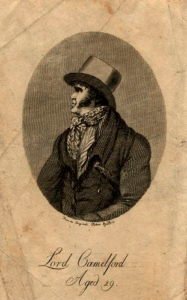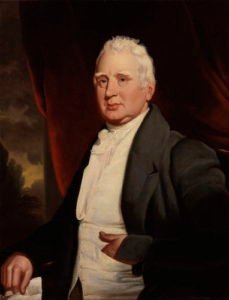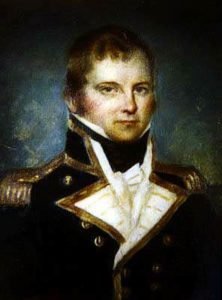Sir Robert Barrie
1774-1841. He was born in St. Augustine, Florida on 5 May 1774, the son of Dr Robert Barrie, a Scottish surgeon s mate serving with the 31st Foot Regiment who died in Robert s infancy on the voyage back to Britain, and Dorothea Dolly Gardner, the sister of Admiral Lord Gardner. His mother later married a successful textile trader, George Clayton, in 1784.
Educated at Neston in Cheshire, and later Dedham School in Essex, Barrie was on the books of the Europa 50 from 1784-8, the pennant ship of Rear-Admiral Alexander Innes and later his uncle, Commodore Alan Gardner in Jamaica. He first saw active service in 1788 aboard the Goliath 74, Captain Sir Andrew Snape Douglas, later joining this officer aboard the Alcide 74 in the Channel. Continuing to enjoy Gardner s patronage, he was a midshipman and then acting-lieutenant during Commander George Vancouver s voyage of exploration to the Pacific coast of North America aboard the Discovery between 1791-5.
Upon returning to England in 1795 Barrie was commissioned lieutenant on 5 November and he joined the Queen 90, Captain William Bedford, the flagship to his uncle, Vice-Admiral Sir Alan Gardner, in the Channel fleet.
From the beginning of 1800 Barrie was the first lieutenant of the ex-French privateer Bourdelais 24, Captain Thomas Manby, an officer with whom he had sailed in the Vancouver Expedition. On 8 January 1801, the Bourdelais having left Portsmouth with a merchant convoy bound for the West Indies, he took two boats in chase of a strange sail off Tenerife, and fourteen hours later, with the one boat that had sustained the marathon row he boarded her under fire from four cannon. The vessel turned out to be a recently-captured London merchantman. He was later wounded but remained at his station when the Bourdelais took the Curieux 18 after a short but particularly stubborn and bloody resistance off Barbados on 29 January, and he had the honour of going aboard the French brig to take possession. Thereafter he was employed for a short while that summer on the Quebec 32, Captain Charles Grant, serving on the Jamaican station.
Remaining in the West Indies, Barrie was promoted commander on 23 October and appointed to the sloop Calypso 16 in place of another of the Vancouver Expedition veterans, the recently posted Captain Joseph Baker. It is said that he also commanded the sloop Shark 16 on the same station, and after being posted captain with seniority from 29 April 1802 he returned to Plymouth in early September from Jamaica as a passenger.
During the peace Barrie spent much of his time in the dissolute company of another old Discovery shipmate, his great friend the controversial Captain Lord Camelford, taking lodgings at the Spring Garden Coffee House near Charing Cross and later at 148 Bond Street. On one occasion he and Camelford were imprisoned overnight and obliged to pay off some night-watchmen having drunkenly attacked and brawled with these men in Cavendish Square. In April 1803 he performed the duties of second to Captain Thomas Macnamara in a duel with Colonel Robert Montgomery at Chalk Farm in which the army officer was mortally wounded. Almost a year later, on 22 April 1804, Macnamara would be acquitted at the Old Bailey of manslaughter.
In the meantime war with France had recommenced, and in July 1803, upon the Bourdelais being re-commissioned, Barrie was appointed to command her. During March 1804 he found himself back in London where he attempted to intercede in the dispute between Lord Camelford and Captain Thomas Best, but his frantic efforts to prevent a fatal duel were unsuccessful and he found himself grieving alongside the politician Lord Grenville as his great friend succumbed to his wounds on his deathbed. In the same month it was reported that he and Captain Macnamara were offered positions in the Irish Sea Fencibles, which he apparently accepted, but in June he was back at the Court of the Kings Bench giving evidence following an assault by Macnamara on a Negro that had resulted in the two captains seeking shelter from an angry mob.
From October 1804 Barrie had the old and unappealing frigate Brilliant 28 off the Clyde, returning to Cork from Scotland in March 1805, and then going out on a ten-day cruise off the Scilly Isles. After remaining at Portsmouth for most of May she sailed into Cork from a cruise in early August before setting out on another cruise a week later. She then returned to Cove from a cruise at the end of November. One of Barrie s captures during this period was the privateer Vaillante 30.
With the accession to government of Lord Grenville in 1806 Barrie was appointed to the crack Pomone 38 on 10 May, and he travelled to Portsmouth to assume her command from Captain Richard Budd Vincent, who had temporarily had her whilst awaiting Barrie to vacate the Brilliant. This vessel underwent a refit at Portsmouth at the end of the year, and serving in the Channel from 21 April to 7 June 1807 Barrie

Barrie was the second to Captain Lord Camelford at his fatal duel, and was a beneficiary of his friend’s will.
took or destroyed upwards of twenty enemy vessels, either in combat or by cutting-out. His most successful day was on 5 June when he fell in with a convoy when chasing three brigs off the Vendean coast. Two of the brigs ran ashore, the third was abandoned to be secured by a boat from the Pomone, and three further boats were despatched towards St. Gilles to capture fourteen vessels of the convoy that had been laying there becalmed. For the rest of the year the Pomone cruised out of Plymouth.
In October 1808 Barrie took a convoy out to Malta, and remaining in the Mediterranean he joined Vice-Admiral Lord Collingwood s fleet patrolling off Toulon. A capture was the new Neapolitan privateer Lucien Charles 3 off Cape Bou on 13 June 1809, aboard which was the eminent Chevalier de Boissi, the adjutant-general of France, whom it was presumed was engaged in a diplomatic mission to the Barbary States. On 22 October the Pomone found Collingwood s fleet to impart the news that a French squadron was at sea, and whilst a detachment under Rear-Admiral George Martin dealt with the threat of the French men-of-war off Cette on 25 October the Pomone and Volontaire 38, Captain Charles Bullen, attacked their attendant convoy and took or destroyed six vessels before the remainder fled into the Bay of Rosas.
Remaining in the Mediterranean, the Pomone captured the French privateers Fortun e 10 on 30 March 1810 and Jupiter 8 on 11 May. A later capture in August was an American-bound ship that was carrying Lucien Buonaparte and his booty, although Barrie refused to claim any of the treasure which he considered to be private property, and his crew honourably refused a cash gift from the dictator s brother, preferring instead to drink his health with a glass of grog at his expense.
Continuing in the Mediterranean, on 18 January 1811 the Pomone took the Toulon privateer Dubourdieu 14, and on 13 March the French man-of-war Etourdie 18 was set on fire by her crew after Barrie s frigate had chased her into Monte Christo Island to the south of Elba. Next learning that a French convoy was loading ship-timber in the Bay of Sagone, Corsica, Barrie joined the Unite 36, Captain Edwin Henry Chamberlayne, and Scout 18, Commander Alexander Renton Sharpe, in attacking it. The three men-of-war were towed in by their boats on 1 May and a close action was maintained with the enemy ships, a Martello tower and shore batteries over the ensuing ninety minutes, following which the French vessels Giraffe 26 and Nourrice 14 were set ablaze to blow up. During the action, which did much to deprive the great French naval base at Toulon of its source of timber, the Pomone lost two men killed and nineteen wounded.
In September 1811 the Pomone left the Dardanelles and headed for England via Malta, Cagliari and Gibraltar with an eminent passenger, Hartford Jones the ambassador to Persia, but on 14 October she struck a submerged rock to the south-west of the Needles off the Isle of Wight. Fortunately her crew, together with her stores and $50,000 were safely taken off. At the court-martial into her loss aboard the Gladiator at Portsmouth on 25 October the Pomone s sailing master was severely reprimanded whilst Captain Barrie and his other officers were acquitted.
From August 1812 he briefly commanded the Grampus 50 off Cadiz, sending half a dozen well laden American captures into Gibraltar, before going out to North America to participate in the War of 1812. In October he exchanged with Captain Francis Collier into the Dragon 74, briefly flying the flag of Rear-Admiral Edward Griffith Colpoys at Halifax, and joining Rear-Admiral Sir George Cockburn s attack on the Chesapeake area between March and August. He then commanded the blockade of the Chesapeake during the most bitter of winters, capturing over eighty-five vessels, and in the summer of 1814 he led a squadron in the same river under the orders of Rear-Admiral Cockburn, who had relieved him at the end of May. June saw him unsuccessfully attacking an American flotilla with rockets and carronades, and he later took one hundred and eighty marines on a sortie up river that destroyed a number of guns and tobacco depots at Benedict and Marlborough, just eighteen miles from Washington.
After departing Halifax on 26 August 1814 following a refit, the Dragon joined Rear-Admiral Edward Griffith s squadron off Metinicus Island in modern day Maine where Barrie led eighty marines and six hundred troops up river to attack the American frigate Adams 26 at Hampden. The assault by river and land was so overwhelming that the Americans fired their own ship on 3 September and fled. Barrie did not stint in punishing the American towns for their opposition, and in so doing he left a lasting resentment of the British. In November he took the squadron s boats up the Rappahanock River where they attacked a force of six hundred militiamen near Tappahanock, releasing some Negro slaves and capturing a field gun in the process. On 11 January 1815 Barrie took possession of Cumberland Island off Georgia, and two days later he led a force of seven hundred troops, marines and seamen in a bloodless assault on the fort at Point Petre.
Once peace brought an end to the War of 1812 the Dragon returned to England, but she was still in commission at Plymouth in March when Napoleon commenced his return to Paris, and she remained so until the autumn, whereupon Barrie went on half-pay, married, and moved to France. On 4 June of the same year he was nominated a C.B.
In September 1818 he was appointed to command the lakes in Canada, and in the following January was given the additional role of commissioner of the dockyard at Kingston in Upper Canada, for where he departed in the spring.

In 1826 Barrie fought a brutal election at Preston in opposition to the political radical William Cobbett.
In 1825 Barrie returned home, and in June of the following year contested the election for Preston in the Tory interest in what proved to be a violent campaign that was greatly disrupted by the mob. Such was the antagonism to his supporters in what was one of the most widely enfranchised constituencies that he called for a troop of cavalry to be on hand to ensure fair play. His entry to the group of candidates appeared to be designed to counter the popularity of the radical, William Cobbett, with the prime motivation being to ensure that Catholics should continue to be required to take the oath of supremacy. During the campaign he and his supporters were stoned at the Hustings, his committee room windows were smashed, and he was labelled as Bob Barrie, the noted dog-fighter . Come the final day of the polls Barrie languished in third place and Cobbett below him, meaning that neither was elected to parliament.
In 1827 Barrie was officially appointed a commodore, and in the late summer he returned to Quebec aboard the Briton 38, Captain George Francis Seymour, to resume his North American duties. He left his post in 1834 upon the dockyard s closure, having earned a reputation as a most active appointee.
On 25 November 1834 Barrie was knighted by King William IV at Brighton with Vice-Admiral Sir Robert Waller Otway assisting at the ceremony. He was promoted rear-admiral on 10 January 1837 and became a K.C.B in 1840.
After retiring to live at Swarthdake, Lancashire, Admiral Barrie died on 7 June 1841.
He married Julia Wharton Ingilby, a younger daughter of the politician Sir John Ingliby FRS, on 24 October 1816 at Harrington Hall, Lincolnshire. He had one son, William Barrie, who was born before this marriage in 1805, and retired with the rank of commander in 1846. He also had four daughters, one of whom, Georgina, became a nun and worked with Florence Nightingale in the Crimean War. His wife predeceased him at Castle Ripley, York on 23 November 1836.
Barrie was a prot g of William Windham Grenville, who became the prime minister in 1806. High-spirited in his youth and a great joker into later life, he was a close friend of the notorious Lord Camelford, having served with him in Vancouver s voyage of discovery. In 1804 he became a beneficiary of his friend s will, having all his debts covered off and enjoying an annuity of 200 guineas a year whilst he was on service and not living within a hundred miles of London. Barrie suffered from rheumatism but was described as being powerful and strong. His language was described as more frank than elegant and he was considered to be a Tory of the old school .

